- 2 Types of Split Attention
- Shifting Attention: Current Understanding
- Information Integration Symmetries: Cognitive Science & Information Digestion Model
- Information Model: Shifting Attention diminishes Potential for Insight.
- Shifting Attention reduces the Energy Density required for Integration.
- Shifting Attention trades Body Pleasure (dopamine) for Mind Joy.
- Internet Surfing & Social Media include the Possibility of Transformation.
2 Types of Split Attention
Questions about Split Attention
What are the pros and cons of split attention?
This is a hot topic currently due to the impact of social media on lifestyle. Some of the questions that arise are: Does regular texting disrupt our ability to learn? What is the impact of constant Facebook referencing on our potential to fully experience life? What are the parameters of these interactions?
What does the Living Algorithm's Information model reveal about Split Attention?
What is the Living Algorithm’s relevance to split attention? The Living Algorithm’s digestion process reveals the rates of change (the derivatives) of any data stream. This process generates a mathematical system. We’ve developed a conceptual model for information digestion based upon the many patterns of correspondence between experimental results and our mathematical system. What insights does our Information Digestion model reveal about the effects of split attention? What guidance does our model provide?
Shifting Attention
In terms of our mathematically based model, there are 2 types of split attention. In the first, attention quickly shifts from one modality to another. This is the type referenced above. An individual is talking with one person, texting with another, referencing Facebook, and doing Google searches for the latest news in a rapid sequential fashion. In this case, our attention is presumably 100% as it shifts from task to task. Internet surfing epitomizes this process. For ease of reference, we will refer to this type of split attention as Shifting Attention.
Divided Attention
In the second, attention is divided. For instance, a toddler's parents must be constantly aware of their child as they complete other tasks. Other examples: an individual is distracted at work because of a sick child at home, a death in the family, or financial difficulties. In these cases, attention on any given modality is never 100%. For ease of reference, we will refer to this type of split attention as Divided Attention.

Living Algorithm model: Interrupted Pulse & 2 Pulses
This division is reflected in our mathematical model. The Living Algorithm's digestion process generates a Pulse of Attention from a Block of Information. Shifting Attention occurs when Attention is directed from one data stream to another before the Pulse has finished its cycle. In other words, there are a series of Pulses that individually have not been completed. In contrast, the state of Divided Attention consists of 2 or more Pulses that are generated simultaneously. Further, these Pulses attain Completion.

What does our model reveal about these 2 types of split attention?
Shifting Attention: Current Understanding
Let's start with the Shifting Attention that is associated with social media and Internet surfing. To provide context for our discussion, let's first review the contemporary scientific understanding regarding this ubiquitous phenomenon. What are the current findings in cognitive science?
Pleasure-producing Dopamine rewards/programs Humans to seek out Fresh Information.
According to Nicholas Carr, the author of The Shallows: What the Internet is doing to our Brain, humans are programmed to seek out information. 'Dopamine, a pleasure producing neuro-transmitter in our brain, rewards us for seeking out or finding new information.' Presumably, those humans that sought out fresh details concerning their environment survived to pass on their gene pool, while the less curious perished before producing offspring. Evidently, the evolutionarily fit gene pool included the production of dopamine as a way of encouraging curiosity about the environment.

Physical Environmental Information about Survival; Mental Environment Not
This genetic propensity for accumulating environmental details was appropriate when the environment was primarily physical. The survival of the tribe, hence species, required knowledge of terrain, seasonal variations, the habits of predator and prey, and whether a particular plant is food, medicine or poison. When our environment became mental with the advent of books and then the Internet, this desire to accumulate new knowledge became disassociated from survival. However, dopamine continues to reward this quest for fresh information.

Information-rich Internet provides Dopamine rush with each click.
The Internet is an information-rich environment, much more so than books. Besides simple text, there is the potential for music, moving pictures, and interaction with friends. With every click of the button, new information sparks the secretion of the pleasure-producing dopamine.
![]()
What's the problem with experiencing pleasure with every new Google search for fresh news about our world?
Attention is the key to Memory Consolidation, the basis of Cognitive Integration.
According to Carr, the problem with constantly shifting attention has to do with 'memory consolidation'. This concerns the 'transfer of information from our working short term memory to our long term memory'. This transfer of information 'creates connections between that information and everything else you know.'

Attention is the key to memory consolidation. 'If we lose attention or are constantly dividing our attention, then we don't really enjoy the consolidation process.'

Shifting Attention does not lead to Memory Consolidation.
Without memory consolidation, there is no integration of facts into our cognitive structure. We begin to think like a computer. Details about the most minute details of existence are only a Google search away, but these random facts are not assimilated into our cognitive network. The ability to access a wide store of information without cognitive assimilation presumably erodes our ability to think 'critically, conceptually and creatively'. In other words, the state of Shifting Attention does not lead to memory consolidation.

Information Integration Symmetries: Cognitive Science & Information Digestion Model
To make sense of the many patterns of correspondence between the Living Algorithm’s mathematical system and experimental findings, we developed a conceptual model that we call the Information Digestion model. Our Information model accords with contemporary understanding of the process of Shifting Attention. Our model further provides a mathematical foundation for this process. The mathematical system expands our knowledge of the underlying parameters behind the common phenomenon of Shifting Attention. To tap into this deeper understanding, let's examine the symmetries between the 2 systems.
Sustained Attention generates a Pulse – an Experience.
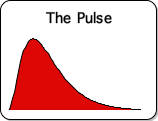
First let’s briefly summarize our Living Algorithm-based Information model. Note: each of the following concepts has a mathematical equivalent. Mind issues mental energy via Attention. Attention must be sustained upon a stream of information for a sufficient duration to generate a Pulse. This completed Pulse of Attention is what we call an ‘Experience’.
Sustained Attention required to transform a Moment into a Life-changing Experience
Attention upon an individual bit of information, a ‘moment’, does not by itself generate an Experience. Attention must be sustained over a series of uninterrupted moments for an Experience to occur. According to our Attention model, Experiences transform Life in some way - perhaps the firing of a neuron or the transfer of information from short-term to long-term memory. In other words, the mental energy behind Sustained Attention is required to transform a 'moment' into a Life-changing 'Experience'.
Sustained Attention: the key to Experience & Memory Consolidation
Sustained Attention is the key to this 'experience' creating process, just as it is for the process of memory consolidation. The above-cited quotation from Carr applies equally to both processes. "If we lose attention or are constantly dividing our attention, then we don't really enjoy the consolidation [experience] process." In other words, constantly shifting Attention blocks both cognitive science's memory consolidation and the Life-changing Experience from our Living Algorithm-based model.

Both Experience & Memory Consolidation transform Information into Knowledge.
The above diagram illustrates that Attention serves an identical function in each model. Sustained Attention is required for both memory consolidation and a Life-changing Experience. Further, cognitive science's memory consolidation and the Living Algorithm Experience both reconfigure our neural networks. This transformation process entails incorporating information into our cognitive structure. If knowledge is defined as assimilated/integrated information, then both processes transform information into knowledge.

Contemporary thinking has it that the changes occur first on the physical level and that the reconfiguration of our neural networks is reflected as the integration of information. Our model suggests that the transformation of information into knowledge could occur first, followed by the physical changes. The net result is the same. Both Body and Mind are changed as a result of the integration process.
Information Model: Shifting Attention diminishes Potential for Insight
Completed Pulse required for Living Experience
Cognitive science's understanding of the Consolidation process ends at this stage. The mathematics behind the virtually identical Experience process reveals much more. According our conceptual model, the Pulse of Attention must be completed to generate an Experience. Mind must exert mental energy to sustain Attention on a particular data stream until the end of the Pulse. Only at the end of the Pulse does the data stream acquire enough energy density to 'spark the gap' between mental and physical, for instance a neural firing or memory consolidation. Another way to describe the same process: a Complete Pulse transforms Information into Knowledge. An Incomplete Pulse does not achieve this same integration of information.
Interrupted Pulse & Shifting Attention
This conceptual model regarding the transformation of information into knowledge was generated to explain the many patterns of correspondence between empirical reality and the Living Algorithm's mathematical system. One of the first congruencies that was uncovered concerns the impact of interruptions on a productive session. Shifting Attention before the end of a Pulse is similar to interrupting the Pulse. Let's briefly review the results of this early study to see what they reveal about Shifting Attention.
Pulse Intensity (Amplitude) associated with Insight
At right is a graph of the ideal Pulse of Attention with a variety of interruptions. The ideal Pulse (red) is in the background. Interruptions to the Pulse are shown as layers in the foreground. The interruptions are of increasingly greater duration (green, dark grey, and light grey). It is clear that these interruptions have a growing negative impact upon the peak of the Pulse. It is equally evident that the Pulse attains its greatest amplitude (the peak) when Attention is uninterrupted. The vertical dimension of the Pulse, its intensity, is associated with insight.
A 10-minute Conversation Pulse
Let's see what this analysis suggests about Shifting Attention. Two people engage in a conversation. According to our model, any human endeavor that requires Attention has the potential for a completed Pulse that is required for a Life-changing Experience. This process includes a simple conversation. Although the length of a Pulse of conversation can vary tremendously depending upon many conditions, let's assume for the sake of discussion that a minimum Conversation Pulse is 10 minutes. This limit is suggested by cognitive science's 10-minute rule.
Conversation Pulse Interruptions: A Negative Impact upon potential for Insight
If an incoming text interrupts the conversation 2 minutes into the dialogue, the Peak is immediately diminished. If another text interrupts the resumed conversation, the Peak is permanently diminished. The Pulse never attains the intensity required for Insight. The conversation remains shallow with very little retained, except perhaps some casual gossip. Parents of young children frequently experience this phenomenon, as their little ones interrupt their interactions with screams for attention. In short, we must sustain the mental energy of our Attention upon a conversation for a sufficient duration to maximize our potential for 'insight'. Conversations that are constantly interrupted by little ones or texting never achieve the ideal Peak that produces Insight. The same process is true of any type of pulse-like behavior that is based upon Attention. According to our model, Shifting Attention, a type of interruption, diminishes the possibility of Insight because the Pulse does not attain its ideal amplitude (peak).

Shifting Attention reduces the Energy Density required for Integration.
Pulse's Energy Density must reach Completion (100%) to Spark the Gap.
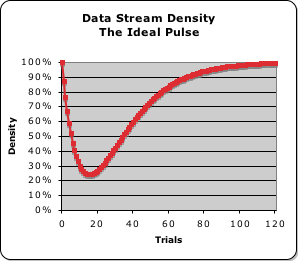
The Peak is just one feature of the Pulse that is negatively impacted by interruptions. The other is Duration. Attention must be sustained for a sufficient Duration to 'spark the gap' between the mental and the physical realms. The reason is straightforward. The energy density of the data stream does not reach completion (100%) until the end of the Pulse. The graph at right visualizes this phenomenon.
The Energy Density reaches 100% upon the Completion of the Pulse
The energy density of a brand new data stream falls at the beginning of the Pulse cycle. This fall presumably opens the participant to the information contained in the fresh data stream. For instance, when we enter a store, we are open to the data stream of its contents. The density then rises steadily until it reaches 100% (completion). At this point according to our theory, there is enough energy density to 'spark the gap'. After browsing in the store, we hone in on a particular product and make a purchase.
When Pulse is Completed, Data Stream Information is transmitted.
In terms of our conceptual model, the information contained in the data stream is transmitted to our neural networks when the energy density is complete. We 'experience' the data stream. In the lexicon of cognitive science, the information is transferred from our working short-term memory to our long-term memory. The memory is consolidated. Information becomes 'knowledge'.
Regular interruptions to the Conversation Pulse to simulate Texting or Young Children
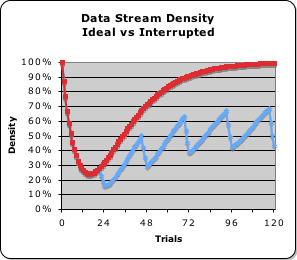
Now let's see what happens when the ideal Pulse is interrupted. Let us assume that the Pulse is simulating a 10-minute conversation. The ideal Pulse, pictured above, is generated when the Living Algorithm digests a data stream consisting of 120 consecutive 1's, no interruptions. Now let us 'interrupt' this ideal data stream with a series of three 0s every 24 trials (iterations of the Living Algorithm process). If the Conversation Pulse is 10 minutes long, this corresponds with a 15 second interruption every 2 minutes. This data stream could simulate the constant interruptions of a young child or of frequent texting.
Regular Interruptions to Conversation Pulse: Incomplete Energy Density – Incomplete Information Transmission.
Notice what happens to the data stream's energy density. Instead of steadily approaching completion at 100%, the energy density never rises above 70%. From the 'lights on, nobody home' study, we saw that even 90% energy density is insufficient to 'spark the gap'. The conversation remains in the trivial range at 70% – no insight and no integration. This could be why a young child's regular demands for attention can be so frustrating to a parent who is attempting to have an 'adult' conversation. This analysis also provides a plausible reason why a conversation with a texting teenager is so unsatisfying. This could be the motivation for the teacher's plea for her students to give her their undivided attention. Regular texting in class obstructs the assimilation of new material, just as it prevents having a fulfilling conversation. The regular interruptions prevent the data stream's energy density from attaining completion (100%). Incomplete Energy Density produces an incomplete information transmission, at best. An incomplete transmission minimizes, or even eliminates, the possibility of a Life-changing Experience/memory consolidation.

The Energy Density of Shifting Attention
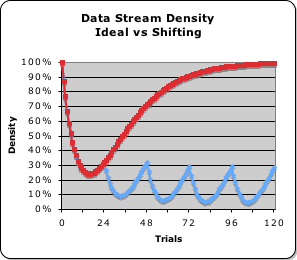
One last scenario. Now let us see what happens when Attention shifts from one topic to another in sequential fashion. To simulate this event, our data stream shifts from 1 to 0 and back again every 24 trials (iterations of the Living Algorithm process). Instead of a 120 uninterrupted 1s, our data stream consists of 24 1s followed by 24 0s, then 24 1s, 24 0s, and then 24 1s. The data stream's energy density is pictured in the graph at right.
Energy Density of Shifting Data Stream (5%->30%): Very Little Information Transmitted
The results are pathetic. The energy density of this shifting data stream never rises above 30%. According to the model, there is no chance of a Life changing experience or a memory consolidation. Let this data stream represent/symbolize a 10-minute Internet session, where the individual is constantly checking Email, texting and researching simultaneously. If knowledge is transmitted in this format, the model indicates that very little information will be retained and even less will be integrated into our cognitive structure.

Shifting Attention trades Body Pleasure (dopamine) for Mind Joy
The state of Shifting Attention seems to trade the short-term rush of the pleasure-producing dopamine for the long-term joy of a quality experience. This tradeoff is also reflected in our model.
Attention attracted to Acceleration to sift Random from Organized Data Streams
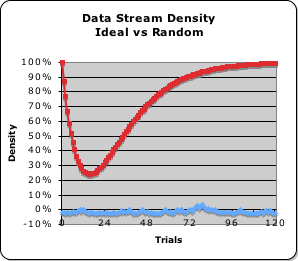
Attention is programmed to be attracted to Change. On the most fundamental level, this attraction is attached to data stream acceleration. The reason is straightforward. Data stream acceleration is the prime factor that determines energy density. By focusing upon a data stream's energy density, Attention can easily differentiate an organized signal from one that is random (see graph at right). Practically speaking, random data streams have no acceleration/energy density. By only focusing upon data streams with acceleration, Attention automatically filters random data streams. This reduces the amount of information that is transmitted to the Mind/Life synergy. This streamlines operations, as there is less information to deal with.
Dopamine encourages Attention's innate attraction to the Rush of Information Acquisition

When the Living Algorithm digests a data stream with consistent content, it generates a pulse of acceleration that we call the Pulse (graph at left). As is evident, the acceleration rises rapidly and then gradually falls. Attention is automatically attracted to the sharply rising acceleration – the Rush. We speculate that this innate tendency is associated with information acquisition and is encouraged by Body's excretion of dopamine. This component of the information digestion process is automatic.

After the Rush fades, Attention seeks out a Fresh Data Stream
After reaching the Peak, the acceleration begins a gradual fall. Interest waning, Attention begins automatically searching for another data stream whose acceleration is rising. However acquisition is only one component of the information process; the second part is assimilation. Information assimilation/memory consolidation only occurs if the Pulse is completed. Only at the end of the Pulse does the data stream's energy density reach completion (100%). This completion is required to 'spark the gap' between mental and physical energy. If Attention is allowed to wander off in search of a new data stream, as is his automatic tendency, the transformation of information into knowledge is incomplete. In the lexicon of cognitive science, memory consolidation does not occur. Both models attribute this deficiency to a lack of sustained Attention.

How is Attention sustained long enough to complete the Pulse?
Our Information model suggests that Attention's natural tendency is to drift off in search of a Rush of new information. We speculate that the brain's production of dopamine even encourages this innate tendency. If automatic tendencies combined with Body's encouragement lead Attention towards jumping ship, how is Attention sustained long enough to complete the Pulse?
Mind must exert Mental Energy to sustain Attention long enough to complete the Pulse.
Mind must exert intent (mental energy) in order to sustain Attention long enough to complete the Pulse required for a Life-changing Experience/memory consolidation. According to our Information Model, Mind's sole mission is to assist Life's quest to realize her potentials (self-actualize). Ideally, Mind is in the business of making Life happy. To fulfill this mission, Mind attunes to Life's innate urges. The Mind/Life synergy then determines which data streams have potential significance to this quest. After this determination has been made, Mind must invest mental energy to transform the data stream's information into knowledge. Or put another way, Mind holds Attention's focus upon the data stream until the end of the Pulse.

2 Phases to Information Assimilation: Automatic Attention & the exertion of Mind Intent
This analysis suggests that there are 2 basic phases to the information digestion process. Attention's initial engagement with a data stream occurs relatively automatically. This coincides with the initial phase of the Pulse – the Rush of acceleration. The 2nd phase requires an assist from Mind. Completing the assimilation/consolidation process requires the exertion of mental energy – Mind Intent. Mind must exert energy to hold Attention upon a significant data stream. The 1st phase of the information digestion process is automatic, while the 2nd phase requires the exertion of mental energy.
Life's Quest for Actualization gives rise to Mind's Craving for Knowledge & Body's Desire for Food.
What's in it for Mind? According to our Information model, Life gave birth to Mind and Body to assist her in her quest for self-actualization. Mind craves knowledge (assimilated information) to fulfill his function. Raw information is not enough. To fulfill this innate urge, Mind invests mental energy to transform information into knowledge. In similar fashion, Body desires food for nourishment to provide Life with vitality and a home.

A Completed Pulse satisfies Mind's craving for Knowledge.
Mind's craving for knowledge is satisfied by a completed Pulse. A completed Pulse transforms information into knowledge, i.e. an 'experience'/memory consolidation. Body's desire for food is satisfied when the stomach has digested enough food to provide nourishment. These desires are primary because they are directly related to Life's quest for self-actualization.

Satisfying the desire for Information Accumulation of secondary importance
The highest priority is satisfying Life's urge for self-actualization, whether digesting food for Body or information for Mind. Satisfying the primary desires associated with Mind and Body’s service of Life is of utmost importance. Information accumulation and taste are secondary desires, even though they lead to the satisfaction of the primary needs. Satisfying the primary desires is much more important than catering to those that are secondary. The tongue craves taste, while the stomach craves nourishment. If the tongue is in charge, the human gets fat. If the stomach rules, the human eats the proper amount and Body is able to serve Life in an optimal fashion.

Satisfying Mind's craving for Knowledge is of primary importance.
In similar fashion, Body derives external dopamine-induced pleasure from the initial Rush of the Pulse associated with information accumulation. This is secondary to the internal 'joy' that Mind derives from the Completed Pulse associated with the generation of knowledge. The reasoning is straightforward. Information accumulation provides Body with momentary pleasure. However, the transformation of information into knowledge enables Mind to serve Life.

Body rewarded for seeking new Information; Mind rewarded for generating Knowledge.
For memory consolidation, let's summarize. To encourage our tendency to acquire environmental information, dopamine is evidently excreted with each new rush of fresh information. Without mental effort, the individual's Attention shifts from topic to topic to get Body's dopamine rush. Information is acquired without assimilation. However, to really assimilate/'experience' the information contained in a data stream, Mind must sustain Attention upon a data stream for a sufficient duration to complete the Pulse. While the initial focus of Attention is automatic, sustained Attention requires the expenditure of mental energy – Mind intent. The reward of this mental effort is a quality experience/memory consolidation. Without mental effort, the only reward is a biological rush. Automatic Attention begins the process and is rewarded physically with dopamine. Sustained Attention finishes the process and is rewarded mentally with an integration of information – knowledge. In the first case, Body is rewarded for seeking out new information. In the second case, Mind is nourished with an integrated Experience.
Life's Quest for Actualization is the Highest Priority, whether digesting Food or Information.
Why is Mind's joy more important than Body's pleasure regarding the process of information assimilation? The transformation of information into knowledge, the root of Mind's joy, assists Life to fulfill her potentials, while the mere acquisition of information (Body's pleasure) does not. The Shifting Attention associated with Web surfing and social media does not assist Life's quest and so is inherently less satisfying than memory consolidation/knowledge generation.
Internet Surfing & Social Media include the Possibility of Transformation
Lest we leave the Reader with an incomplete and therefore misleading understanding, let us provide the other side of the story before leaving this article.
Information-rich Internet encourages Shifting Attention
We have implied that Internet surfing combined with social media is a form of Shifting Attention that blocks the assimilation of information, hence the building of knowledge structures. This statement is only partially true. It is certainly true that the information-rich nature of the Internet encourages the constant alternation of our focus from topic to topic – Shifting Attention. Similarly, bars encourage intoxication. However, if you enter a bar, you don't have to get drunk. In like manner, Shifting Attention is not inherent to the Internet or Facebook.

If Internet Surfing & Social Media include Completed Pulses, Transformation occurs.
We have defined Shifting Attention as a series of Incomplete Pulses. When Internet surfing and social media consist of Incomplete Pulses, information is not assimilated to become knowledge. However, if Internet surfing and social media involvement consist of Complete Pulses, then the transformation occurs. In other words, we assimilate a thorough Internet search on a focused topic, just like any other memory consolidation. Further it is possible to have a satisfying Interactive Experience via texting, if Attention is sustained for long enough.
Lack of Mind Intent is the problem, not the Internet.
According to both models, the problem is not the media; it is Shifting Attention. If mental energy is exerted to sustain Attention on a search or an interaction for sufficient time, a Pulse is generated accompanied by a Life-changing Experience/memory consolidation. It is possible to resist our natural tendency to shift attention from topic to topic. Rather than merely accumulating information, we can instead employ Mind Intent to generate knowledge. Instead of just making Body happy, this strategy enlivens both Mind and Life.

Link
As mentioned in our introduction, Shifting Attention is just one type of Split Attention. To gain a deeper insight into the other type, check out the next article in the stream – Divided Attention & Information Dynamics.
